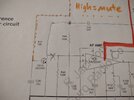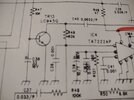I think we can rule out the PLL and TX switching. Testing this new video option to explain why I think that. I will take a closer look at the audio section and squelch/mute after lunch.
View attachment VID_20240215_125109967.mp4
If the PLL was taking time to settle, it should still be getting modulated even if it was off frequency a bit. But the meter needle snapped into action as if something was muting it momentarily.
View attachment VID_20240215_125109967.mp4
If the PLL was taking time to settle, it should still be getting modulated even if it was off frequency a bit. But the meter needle snapped into action as if something was muting it momentarily.


